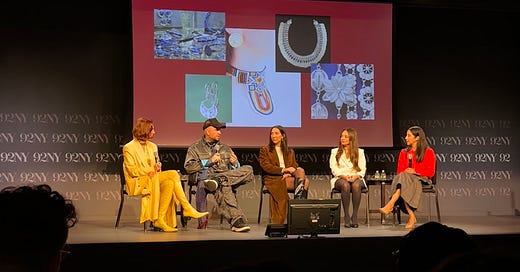Last week, I attended Contemporary Jewelry in the Latin American and Latinx Diasporas, a talk in NYC hosted by Karla Martínez de Salas, Head of Content for Vogue Mexico & Latin America. The event featured renowned jewelry designers and entrepreneurs Paula Mendoza, Vanessa Fernández, Rosario Navia, and Alligator Jesus.
Paula Mendoza (that you see radiantly wearing yellow in the photo) spoke of the pride she’s cultivated throughout her career, building her brand across Colombia, the U.S., and Europe. Today, she fully recognizes her identity as a Latina as a source of that pride, and power.
As I revisited my notes from the evening, I was reminded of the elegance and often glamour we share as a people. We are ambitious and hardworking. We stand close, we touch. Our pursuit of excellence in everything that is tangible is exciting. Seeing Paula’s success made me feel proud of my own roots.
Vanessa Fernández discussed how her Cuban heritage deeply influences her collections, even in the language she chooses for them. For instance, her collection couldn't be named Curve—it is Curva, as it sound so particular and precise in Spanish (somewhat feminine, sinuous, and sensorial). This kind of communication decision felt like an invitation to appreciate the subtleties that can only be fully savored in a source language.
Here's a nod to the Latina brands that often sprinkle in English or French or label themselves as Scandinavian-inspired, perhaps in pursuit of a certain perception of being more expensive. But true chicness? It's about being proud of who you are, where you are, and who your audience is. Here are four wonderful examples.
Alligator Jesus talked about the strength of community and the importance of building relationships. In Latino culture, it feels like everyone is a bit of a cousin or uncle, which brings a sense friendliness and mutual support. He shared his thoughts on the American jewelry market, pointing out its closed and traditional nature. At the same time, he celebrated the rich tradition of jewelry craftsmanship in Latin communities, emphasizing the need to embrace our unique traits as strengths and make our presence felt in more influential spaces within the U.S. market, all while uplifting one another.
Rosario Navia shared how she weaves her Argentine heritage into her work, often drawing inspiration from her grandmother's jewelry, a lasting influence on her aesthetic. She also opened up about the complexities of identity, acknowledging how her appearance might be mistaken for that of a white American, perhaps shaped by years of living in the U.S. Yet, she is profoundly Latina and strives to infuse her work with that depth of feeling.
A thought I often share with clients—and want to emphasize—is that identity, whether Latina, Brazilian, immigrant, or otherwise, naturally shapes our work. There's no need to consciously overly chase it; simply existing infuses everything we create with who we are. This is especially relevant in contemporary product design. Authenticity stems from its source.
Though it’s difficult to include everyone in one conversation, I couldn’t help but notice the absence of Brazilians on stage or by mention. Brazilians are, after all, some of the most influential figures in the industry, particularly Ana Khouri, based here in New York, and Fernando Jorge, who’s about to open his store in the city.
Thank you for reading and enjoy the rest of your week!
Warm regards,
Ísis









